


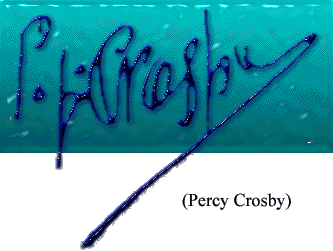
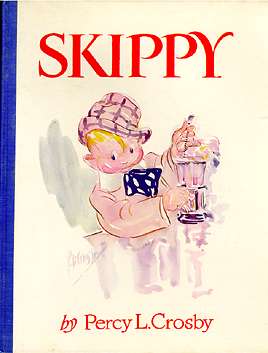
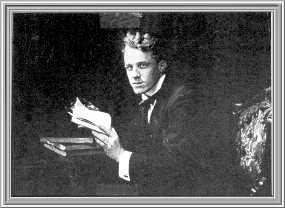 It's nearly
impossible to discuss Percy Crosby without discussing "Skippy",
his most famous creation. Crosby was born in 1890 or '91 in
Richmond Hill, Long Island, New York. "Skippy"
came along in 1923 as a full-page feature in the original Life.
Between the two events, Crosby worked as an editorial cartoonist
(for the socialist New York Daily Call at the age of 19),
sports cartoonist for the New York Globe, staff cartoonist
for the New York World (still only 19), strip cartoonist
(his first being "The Clancy Kids" in 1916),
a second lieutenant in U.S. Army (perfect fodder for a new strip
and book, "That Rookie from the Thirteenth Squad"
and a book of war cartoons, Between Shots), and a student
at the Art Students League. From 1921 to 1925 he created
several panel features, one of which, "Always Belittlin'",
is sometimes credited as being the prototype of Skippy.
It's nearly
impossible to discuss Percy Crosby without discussing "Skippy",
his most famous creation. Crosby was born in 1890 or '91 in
Richmond Hill, Long Island, New York. "Skippy"
came along in 1923 as a full-page feature in the original Life.
Between the two events, Crosby worked as an editorial cartoonist
(for the socialist New York Daily Call at the age of 19),
sports cartoonist for the New York Globe, staff cartoonist
for the New York World (still only 19), strip cartoonist
(his first being "The Clancy Kids" in 1916),
a second lieutenant in U.S. Army (perfect fodder for a new strip
and book, "That Rookie from the Thirteenth Squad"
and a book of war cartoons, Between Shots), and a student
at the Art Students League. From 1921 to 1925 he created
several panel features, one of which, "Always Belittlin'",
is sometimes credited as being the prototype of Skippy.
 Skippy
was a nine year old kid from the streets of America. Crosby's
years at the New York World had exposed him to life in
the city and honed his drawing style into a fluid, slashing, brushstroke
that was to influence the medium. (Doesn't the sequence at left
remind you of the modern antics of "Calvin and Hobbes"?)
Life also featured his watercolor paintings on the cover
of many issues.
Skippy
was a nine year old kid from the streets of America. Crosby's
years at the New York World had exposed him to life in
the city and honed his drawing style into a fluid, slashing, brushstroke
that was to influence the medium. (Doesn't the sequence at left
remind you of the modern antics of "Calvin and Hobbes"?)
Life also featured his watercolor paintings on the cover
of many issues.

The "Skippy" strip in Life exposed him to a nation and gave him a canvas upon which to experiment even further. There's an energy in "Skippy" that was new to the comics page. That fluid brush stroke was applied with more surety and speed. The humor and pathos developed a more universal touch. And the public loved it. By 1925, "Skippy" was a household name. He had a book collection of his Life strips titled, what else, Skippy (see above - this was also published as Life Presents Skippy) and he was starring in his own newspaper strip.
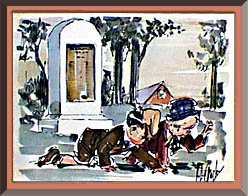 Other
books of the period were: Skippy, an illustrated novel
(which went through four printings in April of 1929!), Dear
Sooky, letters from Skippy to a friend who died, with tipped-in
color plates featuring Crosby's watercolors (also from 1929, see
sample at right), Always Belittlin', in which he
cashed in on the name of his earlier strip in a collection of
short stories featuring Skippy (b&w wash drawings, 1927),
and more. By the mid-Thirties, Skippy was in the movies and on
the song sheets and Crosby was in the money, the museums (see
an example of his dry point etching below) and on top of the world.
He had self-published in 1933 a large limited edition collection
of his watercolor and loose brush art devoted to Sport Drawings.
His art appeared regularly in the annuals of the Dutch Treat Club.
Other
books of the period were: Skippy, an illustrated novel
(which went through four printings in April of 1929!), Dear
Sooky, letters from Skippy to a friend who died, with tipped-in
color plates featuring Crosby's watercolors (also from 1929, see
sample at right), Always Belittlin', in which he
cashed in on the name of his earlier strip in a collection of
short stories featuring Skippy (b&w wash drawings, 1927),
and more. By the mid-Thirties, Skippy was in the movies and on
the song sheets and Crosby was in the money, the museums (see
an example of his dry point etching below) and on top of the world.
He had self-published in 1933 a large limited edition collection
of his watercolor and loose brush art devoted to Sport Drawings.
His art appeared regularly in the annuals of the Dutch Treat Club.
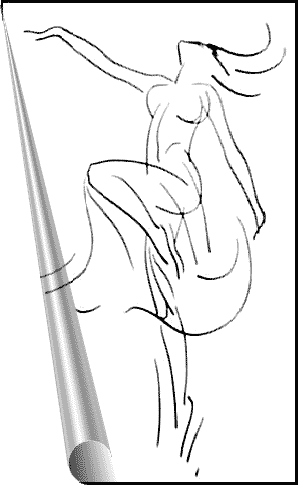 Having
survived the Wall Street Crash and the depths of the depression,
Crosby fell victim to his political fervor and bouts of alcoholism.
Much of his writings outside of the Skippy books and strip were
of a political nature. Titles like Three Cheers for the Red,
Red and Red were self-published because the mainstream publishers
were both uncomfortable with a book that proclaimed FDR to be
a Communist and fairly certain that it would be a commercial failure.
They were right on the latter point. Crosby continued to spend
money to proselytize his beliefs. He published books like A
Cartoonist's Philosophy, paid for full-page ads in the major
papers to publish articles rejected by Life, even revived
Always Belittlin' as a title for a book on political thought.
He was anti prohibition, anti Klu Klux Klan (anti-bigotry in any
form), and was certain that both J. Edgar Hoover and FDR were
operating outside of the powers with which they were vested. He
thought the New Deal was rampant socialism and paid for the publication
of cartoons and editorials that said so. As his fortune dwindled,
so did his ability to amuse the public and a vicious downward
cycle began. His wife divorced him in 1939 and he was never to
see her or his children again. The "Skippy" strip
became less about life and more about politics, less about hope
and more about depression, less appealing, less read, less important.
Until King Features failed to renew the strip and "Skippy"
was canceled on Crosby's birthday, December 8, 1945.
Having
survived the Wall Street Crash and the depths of the depression,
Crosby fell victim to his political fervor and bouts of alcoholism.
Much of his writings outside of the Skippy books and strip were
of a political nature. Titles like Three Cheers for the Red,
Red and Red were self-published because the mainstream publishers
were both uncomfortable with a book that proclaimed FDR to be
a Communist and fairly certain that it would be a commercial failure.
They were right on the latter point. Crosby continued to spend
money to proselytize his beliefs. He published books like A
Cartoonist's Philosophy, paid for full-page ads in the major
papers to publish articles rejected by Life, even revived
Always Belittlin' as a title for a book on political thought.
He was anti prohibition, anti Klu Klux Klan (anti-bigotry in any
form), and was certain that both J. Edgar Hoover and FDR were
operating outside of the powers with which they were vested. He
thought the New Deal was rampant socialism and paid for the publication
of cartoons and editorials that said so. As his fortune dwindled,
so did his ability to amuse the public and a vicious downward
cycle began. His wife divorced him in 1939 and he was never to
see her or his children again. The "Skippy" strip
became less about life and more about politics, less about hope
and more about depression, less appealing, less read, less important.
Until King Features failed to renew the strip and "Skippy"
was canceled on Crosby's birthday, December 8, 1945.
Three years later, Crosby attempted suicide and spent the rest of his life (he died in 1964, also on his birthday) in the mental ward of Kings Park Veterans' Hospital. His children and public believed him dead. He was classified a paranoid schizophrenic for his assertions that the FBI and IRS were after him and that Skippy Peanut Butter had infringed on his copyright. All of which were probably quite true, but his depression and suicide attempt, and the fact that his second wife would not assume responsibility for his well-being kept him a literal prisoner for life. His daughter, Joan Crosby Tibbetts, continues the struggle to keep his name and reputation alive. His contributions to the comic strip and the kid strip especially have never died. Strips as diverse as "Peanuts", "Pogo", and "Doonesbury" are indebted to his efforts.
The vast majority of this page is taken from Jerry Robinson's excellent biography, Skippy and Percy Crosby. Highly recommended.
 To learn more about Percy Crosby, see:
To learn more about Percy Crosby, see:
| Skippy and Percy Crosby | Jerry Robinson, 1978 Holt Rinehart Winston |
| The Vadeboncoeur Collection of Knowledge | Jim Vadeboncoeur, Jr. 1998 |
|
Illustrations copyright by
their respective owners. This page written, designed & © 1998 by Jim Vadeboncoeur, Jr. Updated 2011. |
